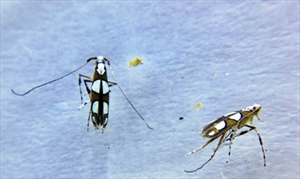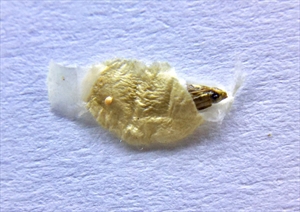Malay (or rose) apple leafminer; there is no accepted common name for this leafminer blotch moth.
Pacific Pests, Pathogens, Weeds & Pesticides - Online edition
Pacific Pests, Pathogens, Weeds & Pesticides
Malay (rose) apple leafminer (371)
Acrocercops patellata. It is a moth of the Gracillariidae.
Unknown. It is recorded from Papua province (Irian Jaya), Indonesia, and Fiji. Possibly, in Papua New Guinea and Solomon Islands.
Malay (or rose) apple. It is also called rose apple, mountain apple, water apple. The scientific name of the host is Syzygium malaccense.
The larvae do the damage, mining along the major veins, extending over the entire leaf surface in severe attacks (Photos 1&2). The leaves become thin and eventually shrivel and die.
The adult moth is about 3 mm long, with a wingspan of 6 mm (Photo 3). It has four, distinctive, white, semicircular spots with black borders on each forewing, against a brown background. The central two spots are much larger than those on either side. Hindwings are brownish and fringed. The top of the head and abdomen are also white. Antennae are longer than the body. Pupae are brown and occur in crevices on the leaf (Photos 4&5).
Spread is on the wing, and via the trade in nursery plants.
Severe damage occurs to individual leaves, but the number of leaves damaged on any one tree appears to be low. For this reason, it is very unlikely that fruit yields are affected by the damage. Plants in the nursery may be more seriously impacted, limiting growth.
Look for the characteristic white spots on the forewings of the moth, the long antennae and the fringed hindwings.
CULTURAL CONTROL
It is unlikely that the leafminer causes sufficient damage on mature trees to warrant control. However, should it become severe on young trees in a nursery then squash the larvae in their tunnels with finger and thumb or, if numbers are too large to squash, removed the infested leaves with mines as soon as they are seen and burn them.
CHEMICAL CONTROL
If cultural control measures are not sufficient to manage outbreaks in nurseries, spray with imidacloprid (or another nicotinoid), or use a contact product, such as a synthetic pyrethroid. Imidacloprid has the advantage of being systemic.
____________________
When using a pesticide, always wear protective clothing and follow the instructions on the product label, such as dosage, timing of application, and pre-harvest interval. Recommendations will vary with the crop and system of cultivation. Expert advice on the most appropriate pesticide to use should always be sought from local agricultural authorities.
AUTHORS Grahame Jackson & Mani Mua
Information from van Haren MM (undated) The leaf blotch miner moths (Lepidoptera: Gracillariidae: Gracillariinae) of Papua Indonesia. (https://www.papua-insects.nl/insect%20orders/Lepidoptera/Gracillariidae/Acrocercops/Acrocercops%20patellata.htm).
Produced with support from the Australian Centre for International Agricultural Research under project HORT/2016/185: Responding to emerging pest and disease threats to horticulture in the Pacific islands, implemented by the University of Queensland and the Secretariat of the Pacific Community.








